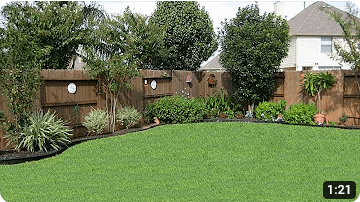
4 Tips for Landscaping Along Your Fence Line
A well-landscaped yard can make all the difference in terms of curb appeal. But if you’re like most homeowners, you probably don’t have a lot of extra time or money to spend on landscaping your entire property. That’s why focusing on one specific area, like the fence line, can be a great way to make a big impact without breaking the bank.
Here are four tips for landscaping along your fence line:

- Decide on a style and stick to it.
You might be tempted to try out a bunch of different styles for your landscaping, but that will only end up making your yard look cluttered and messy. Instead, pick one style that you like and stick to it throughout your landscaping. This will create a cohesive look that is much more visually appealing. - Use low-maintenance plants.
There’s no need to choose high-maintenance plants that require a lot of watering and upkeep. Stick with low-maintenance plants that are drought-resistant and able to thrive in your climate. This will save you time and money in the long run. - Mulch around your plants.
Mulching is not only good for your plants, but it also helps to prevent weeds from growing. You can find mulch at most home improvement stores or online retailers. Be sure to spread it around your plants evenly and give them a good amount of coverage. - Consider using decorative stones or other accents.
In addition to plants, there are other ways to spruce up your fence line landscaping. Decorative stones or other accents can add visual interest and texture to your yard. Be sure to choose accents that complement the overall style of your landscaping for the best results.
By following these tips, you can easily create an attractive and eye-catching fence line landscape that will boost your curb appeal and make your neighbors green with envy!
Grouping Plants Together to Achieve a More Natural Look
Have you ever looked at a landscape and thought it looked too perfect? Maybe the plants were all the same height, or they were spaced too evenly apart. If you’re going for a more natural look, one of the best things you can do is group plants together in clusters.
Why Group Plants Together?
When you group plants together, it gives the landscape a more organic feel. It also helps to camouflage any bare spots in your yard, since the plants will conceal them. Another benefit of grouping plants together is that it can save you money. Buying several small plants is usually cheaper than buying one large plant, so if you group them together, you’ll get more bang for your buck.
How to Group Plants Together
The first step is to plan out your landscaping before you start planting. This will help you figure out how many plants you need, and where they should go. Once you have a plan, make sure all your plants are healthy before putting them in the ground. Once they’re in, water them well and give them some time to adjust to their new home. After a few weeks, you should start to see some new growth.
Grouping plants together is a great way to achieve a more natural look in your landscaping. It’s also economical and can help to camouflage any bare spots in your yard. With a little planning and patience, you can have a beautiful, organic-looking landscape that will be the envy of your neighborhood.
Below are some landscaping tips and ideas you can consider for improving your fence line:
• Before starting to plant along fence the line, make sure you remove any brush and debris on the area. This means removing weeds growing along the privacy fence. You can use a weed trimmer to cut down weeds and grass next to the fence.
• Aside from planting ornamental plants, the area along the fence is the ideal location to grow long, narrow vegetable garden beds. The edible garden will decorate and improve the look of the area while making the space functional to produce your own food.
• If you want to cover some of the wooden fence’s parts (especially the old, rotten ones) plant vines, like bougainvillea or trumpet vine along the base of the fence. These vines will naturally grow up the fence to add color to your fence and at the same time, soften the look of the wood.
• If you want to grow plants along the fence line, grow tall ornamental grasses, such as cape thatching reed or muhly grass, along the area. When they grow, they will fill out to cover a large area of the fence while adding movement and texture to your outdoor space.
• To have blooming flowers near your fence, plant ornamental grasses with flowering perennials such as poppies or hydrangeas. You can also consider growing flowering herbs like chives and lavender since they work great for different types of border gardens.
• You can also consider planting pots. Place large, decorative pots along the fence line. Make sure you pace the pots evenly along the privacy structure. To add color and boost visual interest to the area, grow a variety of plants in one pot.
• Lastly, to improve the look of your fence and outdoor space, you can also hang decorative garden fixtures such as metal lanterns as accent pieces. However, make sure you choose only lightweight garden decorations that won’t cause the fence to sag or lean and screw the pieces into the wood securely.
